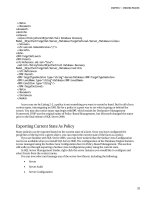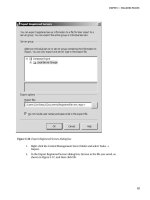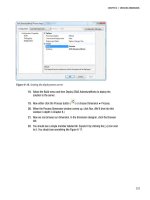Apress - Pro SQL Server 2008 Relational Database Design and Implementation (2008)03
Bạn đang xem bản rút gọn của tài liệu. Xem và tải ngay bản đầy đủ của tài liệu tại đây (325.3 KB, 15 trang )
A thorough database design process will undergo four distinct phases, as follows:
•
Conceptual: This is the “sketch” of the database that you will get from initial requirements
gathering and customer information. During this phase, you attempt to identify what the
user wants. You try to find out as much as possible about the business process for which you
are building this data model, its scope, and, most important, the business rules that will gov-
ern the use of the data. You then capture this information in a conceptual data model
consisting of a set of “high-level” entities and the interactions between them.
•
Logical: The logical phase is a refinement of the work done in the conceptual phase, trans-
forming what is often a loosely structured conceptual design into a full-fledged relational
database design that will be the foundation for the implementation design. During this
stage, you fully define the required set of entities, the relationships between them, the attrib-
utes of each entity, and the domains of these attributes (i.e., the sort of data the attribute
holds and the range of valid values).
•
Implementation: In this phase, you adapt the logical model for implementation in the host
relational database management system (RDBMS; in our case, SQL Server).
•
Physical: In this phase, you create the model where the implementation data structures are
mapped to physical storage
. This phase is also more or less the performance tuning/optimiza-
tion phase of the project because it is important that your implementation should function in
the same way no matter what the physical har
dware looks like. It might not function very fast,
but it will function. It is during this phase of the project that indexes, disk layouts, and so on,
come into play, and not before this.
The first four chapters of this book are concerned with the conceptual and logical design
phases, and I make only a few references to SQL Server. Generally speaking, the logical model of any
relational database will be the same, be it for SQL Server, Oracle, Informix, DB2, MySQL, or any-
thing else based, in some measure, on the relational model.
■
Note
A lot of people use the name physical to indicate that they are working on the SQL Data Definition
Language (DDL) objects, rather than the meaning I give, where it is the layer “below” the SQL language. But lump-
ing both the DDL and the tuning layers into one “physical” layer did not sit well with some readers/reviewers, and
I completely agree. The implementation layer is purely SQL and doesn’t care too much about tuning. The physical
layer is pure tuning, and nothing done in that layer should affect the meaning of the data.
Conceptual
The conceptual design phase is essentially a process of analysis and discovery, the goal being to
define the or
ganizational and user data r
equirements of the system. Note that there are other parts
to the overall design picture beyond the needs of the database design that will be part of the con-
ceptual design phase (and all follow-on phases), but for this book, the design process will be
discussed in a manner that may make it sound as if the database is all that matters. (As a reader of
this book who is actually reading this chapter on fundamentals, you probably feel that way already.)
Two of the core activities that make up this stage are as follows:
• Discovering and documenting a set of entities and the relationships between them
• Discovering and documenting the business rules that define how the data can and will be
used and also the scope of the system that y
ou are designing
CHAPTER 1
■
INTRODUCTION TO DATABASE CONCEPTS 3
8662Ch01.qxp 7/28/08 3:37 PM Page 3
Your conceptual design should capture, at a high level, the fundamental “sets” of data that are
required to support the business processes and users’ needs. Entity discovery is at the heart of this
process.
Entities correspond to nouns (people, places, and things) that are fundamental to the busi-
ness processes you are trying to improve by creating software. Consider a basic business statement
such as the following:
People place orders in order to buy products.
Immediately, you can identify three conceptual entities (in bold) and begin to understand how
they interact. Note too, phrases such as “in order” can be confusing, and if the writer of this spec
were writing well, the phrase would have been “
People place orders to buy products.”
■
Note
An entity is not the same thing as a table. A table is an implementation-specific SQL construct. Sometimes
an entity will map directly to a table in the implementation, but often it won’t. Some conceptual entities will be too
abstract to ever be implemented, and sometimes they will map to two or more tables. It is a major (if somewhat
unavoidable because of human nature) mistake at this point of the process to begin thinking about how the final
database will look.
The primary point of this note is simply that you should not rush the design process by worrying about implemen-
tation details until you start to flip bits on the SQL Server. The next section of this chapter will establish the
terminology in more detail. In the end, one section had to come first, and this one won.
During this conceptual phase, you need to do the requisite planning and analysis so that the
requirements of the business and its customers are met. The conceptual design should focus stead-
fastly on the broader view of the system, and it may not correspond to the final, implemented
system. However, it is a vital step in the process and provides a great communication tool for partic-
ipants in the design process.
The second essential element of the conceptual phase is the discovery of
business rules. These
are the rules that govern the operation of your system, certainly as they pertain to the process of
creating a database and the data to be stored in the database. Often, no specific tool is used to doc-
ument these rules, other than Microsoft Excel or Word. It is usually sufficient that business rules are
pr
esented as a kind of checklist of things that a system must or must not do, for example:
• Users in group X must be able to change their own information.
• Each company must have a ship-to address and optionally a bill-to address if its billing
address is different.
• A product code must be 12 characters in length and be in the format XXX-XXX-XXXX.
From these statements, the boundaries of the final implemented system can be determined.
These business rules may encompass many different elements of business activity. They can range
from very specific data-integrity rules (e.g., the newly created order date has to be the current date)
to system processing rules (e.g., report X must run daily at 12 a.m.) to a rule that defines part of the
secur
ity str
ategy (e
.g., only this categor
y of users should be able to access these tables). E
xpanding
on that final point, a security plan ought to be built during this phase and used to implement data-
base security in the implementation phase. Too often, security measures are applied (or not) as an
after
thought.
CHAPTER 1
■
INTRODUCTION TO DATABASE CONCEPTS4
8662Ch01.qxp 7/28/08 3:37 PM Page 4
■
Note
It is beyond the scope of this book to include a full discussion of business rule discovery, outside of what
is needed to shape and then implement integrity checks in the data structures. However, business rule discovery is
a very important process that has a fundamental impact on the database design. For a deeper understanding of
b
usiness rules, I suggest getting one of the many books on the subject.
During this process, you will encounter certain rules that “have to” be enforced and others that
are “conditionally” enforced. For example, consider the following two statements:
• Applicants must be 18 years of age or older.
• Applicants should be between 18 and 32 years of age, but you are allowed to accept people of
any age if you have proper permission.
The first rule can easily be implemented in the database. If an applicant enters an age of 17
years or younger, the RDBMS can reject the application and send back a message to that effect.
The second rule is not quite so straightforward to implement. In this case, you would probably
require some sort of workflow process to route the request to a manager for approval. T-SQL code is
not inter
active, and this rule would most certainly be enforced outside the database, probably in
the user interface (UI).
It pays to be careful with any rule, even the first. No matter what the initial rules state, the lee-
way to break the rules is still a possibility. Unfortunately, this is just part of the process. The
important thing to recognize is that every rule that is implemented in an absolute manner can be
trusted, while breakable rules must be verified with every usage.
■
Note
Ideally, the requirements at this point would be perfect and would contain all business rules, processes,
and so forth, needed to implement a system. The conceptual model would contain in some form every element
needed in the final database system. However, we do not live in a perfect world. Users generally don’t know what
they want until they see it. Business analysts miss things, sometimes honestly, but often because they jump to
conclusions or don’t fully understand the system. Hence, some of the activities described as part of building a
conceptual model can spill over to the logical modeling phase.
Logical
The logical phase is a refinement of the work done in the conceptual phase. The output from this
phase will be an essentially complete blueprint for the design of the relational database. Note that
dur
ing this stage y
ou should still think in terms of entities and their attributes, rather than tables
and columns. No consideration should be given at this stage to the exact details of “how” the system
will be implemented. As previously stated, a good logical design could be built on any RDBMS. Core
activities during this stage include the following:
• Drilling down into the conceptual model to identify the full set of entities that define the system.
•
D
efining the attr
ibute set for each entity
. F
or example, an
Order entity may hav
e attr
ibutes
such as
Order Date, Order Amount, Customer Name, and so on.
• Applying normalization rules (covered in Chapter 4).
CHAPTER 1
■
INTRODUCTION TO DATABASE CONCEPTS 5
8662Ch01.qxp 7/28/08 3:37 PM Page 5
• Identifying the attributes (or a group of attributes) that make up candidate keys (i.e., sets of
attributes that could uniquely identify an instance of an entity). This includes primary keys,
foreign keys, surrogate keys, and so on (all described in Chapter 5).
• Defining relationships and associated cardinalities.
• Identifying an appropriate domain (which will become a datatype) for each attribute and
whether values are required.
While the conceptual model was meant to give the involved parties a communication tool to
discuss the data requirements and to start seeing a pattern to the eventual solution, the logical
phase is about applying proper design techniques. The logical modeling phase defines a blueprint
for the database system, which can be handed off to someone else with little knowledge of the sys-
tem to implement using a given technology (which in our case is likely going to be some version of
Microsoft SQL Server).
■
Note
Before we begin to build the logical model, we need to introduce a complete data modeling language. In
our case, we will be using the IDEF1X modeling methodology, described in Chapter 2.
Implementation
During the implementation phase, you fit the logical design to the tool that is being used (in our
case, an RDBMS, namely, SQL Server). This involves choosing datatypes, building tables, applying
constr
aints
, writing triggers, and so on, to implement the logical model in the most efficient man-
ner. This is where platform-specific knowledge of SQL Server, T-SQL, and other technologies
becomes essential.
Occasionally this phase will entail some reorganization of the designed objects to make them
easier to implement or to circumvent some inherent limitation of the RDBMS. In general, I can state
that for most designs there is seldom any reason to stray a great distance from the logical model,
though the need to balance user load and hardware considerations can make for some changes to
initial design decisions. Ultimately, one of the primary goals is that no data that has been specified
or integrity constraints that have been identified in the conceptual and logical phases will be lost.
Data can (and will) be added, often to handle the process of writing programs to use the data. The
key is to not affect the designed meaning or, at least, not to take anything away from that original
set of requirements.
I
t is at this point in the pr
oject that constructs will be applied to handle the business rules that
w
er
e identified dur
ing the conceptual par
t of the design.
These constr
ucts will vary from the
favored declarative constraints such as defaults, check constraints, and so on, to less favorable but
still useful triggers and occasionally stored procedures. Finally, this phase includes designing the
secur
ity for the data w
e will be storing. We will work through the implementation phase of the proj-
ect in Chapters 5, 6, 7, and 8.
■
Note
In many modeling tools, the physical phase denotes the point where the logical model is actually generated
in the database. I will refer to this as the
implementation phase because the physical model is also commonly used
to describe the process by which the data is physically laid out onto the hardware. I also do this because it should
not be confusing to the reader what the implementation model is, regardless of the name they use to call this phase
of the process.
CHAPTER 1
■
INTRODUCTION TO DATABASE CONCEPTS6
8662Ch01.qxp 7/28/08 3:37 PM Page 6
Physical
T
he goal of the physical phase is to optimize data access—for example, by implementing effective
data distribution on the physical disk storage and by judicious use of indexes. While the purpose of
the RDBMS is to largely isolate us from the physical aspects of data retrieval and storage, it is still
very important to understand how SQL Server physically implements the data storage in order to
optimize database access code.
During this stage, the goal is to optimize performance, but to not change the logical design in any
way to achieve that aim. This is an embodiment of Codd’s eleventh rule, which states the following:
An RDBMS has distribution independence. Distribution independence implies that users
should not have to be aware of whether a database is distributed.
■
Note
We will discuss Codd’s rules in Appendix A.
It may be that it is necessary to distribute data across different files, or even different servers,
but as long as the published logical names do not change, users will still access the data as columns
in rows in tables in a database.
■
Note
Our discussion of the physical model will be reasonably limited. We will start by looking at entities and
attributes during conceptual and logical modeling. In implementation modeling, we will switch gears to deal with
tables, rows, and columns. The physical modeling of records and fields will be dealt with only briefly (in Chapter 8).
If you want a deeper understanding of the physical implementation, check out
Inside Microsoft SQL Server 2005:
The Storage Engine
by Kalen Delaney (Microsoft Press, 2006) or any future books she may have released by the
time you are reading this.
Relational Data Structures
This section introduces the following core relational database structures and concepts:
• Database and schema
• Tables, rows, and columns
• The Information Principle
• Keys
• Missing values (nulls)
As a person reading this book, this is probably not your first time working with a database, and
as such, you are no doubt somewhat familiar with some of these concepts. However, you may find
ther
e are quite a few points presented here that you haven’t thought about—for example, the fact
that a table consists of unique r
o
ws or that within a single r
o
w a column must r
epr
esent only a sin
-
gle value. These points make the difference between having a database of data that the client relies
on without hesitation and having one in which the data is constantly challenged.
CHAPTER 1
■
INTRODUCTION TO DATABASE CONCEPTS 7
8662Ch01.qxp 7/28/08 3:37 PM Page 7
Database and Schema
A d
atabase
i
s simply a structured collection of facts or data. It need not be in electronic form; it
could be a card catalog at a library, your checkbook, a SQL Server database, an Excel spreadsheet, or
even just a simple text file. Typically, when a database is in an electronic form, it is arranged for ease
and speed of search and retrieval.
In SQL Server, the database is the highest-level container that you will use to group all the
objects and code that serve a common purpose. On an instance of the database server, you can
have multiple databases, but best practices suggest using as few as possible for your needs. At the
next level down is the
schema. You use schemas to group objects in the database with common
themes or even common owners. All objects on the database server can be addressed by knowing
the database they reside in and the schema (note that you can set up linked servers and include a
server name as well):
databaseName.schemaName.objectName
Schemas will play a large part of your design, not only to segregate objects of like types but also
because segregation into schemas allows you to control access to the data and restrict permissions,
if necessary, to only a cer
tain subset of the implemented database.
Once the database is actually implemented, it becomes the primary container used to hold,
back up, and subsequently restore data when necessary. It does not limit you to accessing data
within only that one database; however, managing data in separate databases becomes a mor
e
manual process, rather than a natural, built-in RDBMS function.
■
Caution
The term schema has another common meaning that you should realize: the entire structure for the
databases is referred to as the schema.
Tables, Rows, and Columns
The object that will be involved in all your designs and code is the table. In your designs, a table will
be used to represent
something, either real or imaginary. A table can be used to represent people,
places, things, or ideas (i.e., nouns, generally speaking), about which information needs to be
stor
ed.
The word
table has the connotation of being an implementation-oriented term, for which
Dictionary.com (
) has the following definition:
A
n or
derly arrangement of data, especially one in which the data are arranged in columns
and rows in an essentially rectangular form.
A basic example of this form of table that most people are familiar with is a Microsoft Excel
spreadsheet, such as that shown in Figure 1-1.
CHAPTER 1
■
INTRODUCTION TO DATABASE CONCEPTS8
8662Ch01.qxp 7/28/08 3:37 PM Page 8









